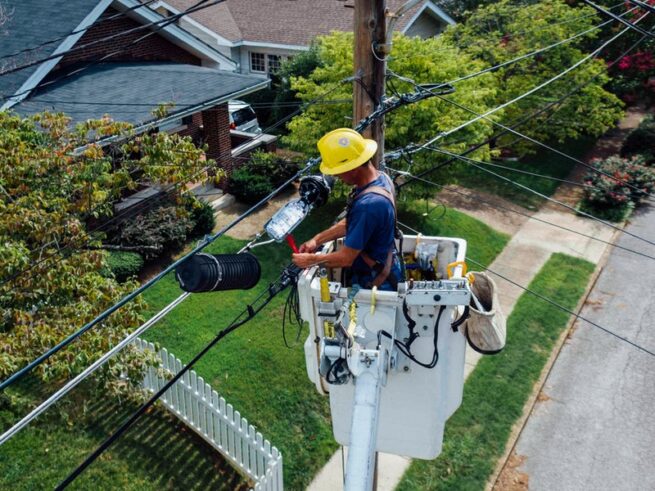
Your roof, siding, and gutters all have an important job to do. They are your first line of defense against the elements and critical to the overall integrity of your home. However, the weather is your home exteriors most powerful nemesis. From snowstorms to high winds to hail, storms can be incredibly damaging to your home.
What weather events cause the most storm damage to your home exterior?
HAILSTORMS
Hailstorms usually leave behind evidence of their wrath. We have all seen broken windows, dented car hoods, cracked siding, mashed plants and even some missing roofing shingles. However, there could be some more subtle signs when it comes to your roof.
Regardless of the roofing material you use, hail can create small fractures in the shingle and weaken the roof as a whole. Over time, this can lead to larger cracks and tears. In addition, depending on the size of the hail and the intensity of the storm, sections of your roof could have been weakened during the madness. Think about it. Your roof just got pummeled over and over again by ice balls.
How can you catch this before it turns into a problem? Make sure that whatever roofing material you have chosen for your home is strong and durable and always call for a professional inspection following a hailstorm. Inspections are free and you can get a little peace of mind.
WINDSTORMS
When your roof goes through a windstorm or high winds in general, it can loosen the tiny granules on shingles that help keep water out. These granules can wash into gutters, causing them to clog, backup, or overflow. In addition, your roof could straight up be missing some shingles. Missing shingles most definitely leaves your roof vulnerable to the elements.
High winds can also lift and loosen siding panels, disrupting the tongue-and-groove system that makes them watertight. It can also completely remove sections of siding completely, also leaving your home vulnerable to the elements.
Debris – such as seeds, branches, and leaves – blown around in windstorms can hit your siding, leaving cracks. It can also land in gutters, causing them to clog or overflow, causing poor water drainage.
What should you do? Inspect your home and make any necessary replacements right away. Again, if you are concerned about your home, call your local expert for an inspection.
RAINSTORMS AND THUNDERSTORMS
This one seems pretty obvious but needs to be included. Rain is water, and water is wet. Your roof is regularly exposed to these kinds of conditions and after a while, it can certainly take its toll–especially if any other weather event like wind or hail is mixed in there.
What’s our advice? Again, check out your home’s exterior after any major storm. Have you noticed any mold or fungus inside your home or on your roof? Are your heating and cooling costs really high? This could be a sign of a damage that requires immediate attention.
SNOWSTORMS
The most common issue when dealing with snowy roofs are ice dams. Ice dams are large ridges of ice that form at the edge of a roof or gutters, and prevent melting snow from running off the roof. When water cannot runoff the roof, it can back-up on the roof and cause leaks.
What can you do? Remove snow from your roof after each storm. This eliminates one of the needed components for ice dams. In the unfortunate event that you discover that ice dams are already present, do not start hacking away at them. The best way to remove them is to have a professional come out to perform a steam removal. Steam removal is effective, non-damaging and much more quiet for your neighbors.
THE BOTTOM LINE
Weather and storms take a damaging toll on your roof, gutters and siding. Stay on top of potential storms and severe weather in your area by keeping an eye on local meteorology reports or using resources such as The National Weather Service. But most importantly, make sure that you’re getting your home’s exterior inspected after major storms and get the necessary replacements done as soon as possible.
Unsure if your home sustained damage from a storm? Let Greenawalt help! Schedule your free inspection with one of our Storm Damage experts.
What to Do If You Suspect Storm Damage
Step 1: Before You File a Claim
If you think your roof or property has been damaged by a storm, contact a reputable company, like Greenawalt, to come out and provide a free inspection.
Step 2: Meet With Your Contractor
Schedule the inspection before a claim is filed. The damage may not be as great as you think. If it is less than, or close to, your insurance deductible, filing a claim may not be in your best interest.
Step 3: File Your Insurance Claim
If the contractor’s estimate warrants filing a claim, do so now. Your insurance company will most likely schedule an adjuster to inspect your home to approve and process your claim.
Step 4: Meet With Your Adjuster
Insurance adjusters have a home inspection checklist they will follow when determining the damage done to your home. Schedule a time when your contractor can also attend this inspection. Greenawalt’s claims specialists can be your advocates during the insurance inspection.
Step 5: Claim Approval
Once your claim is approved, go over the details of the insurance coverage. The claims specialists at Greenawalt can help you understand everything the insurance company is covering.
Step 6: Time for Your Project to Begin
When you have received the answers to your questions, sign the contract with Greenawalt and get your replacement work scheduled.
For more information on Greenawalt Roofing visit greenawaltroofing.com





More Stories
Buying a Condo
Red, White and Blue – What Are The Timeshare Seasons?
What You Need to Know About Selling Your Condominium in Today’s Market